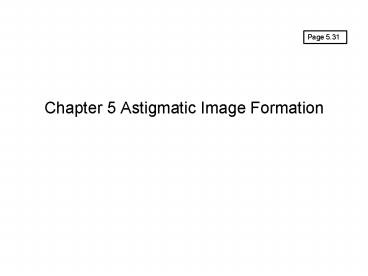Chapter 5 Astigmatic Image Formation PowerPoint PPT Presentation
1 / 25
Title: Chapter 5 Astigmatic Image Formation
1
Chapter 5 Astigmatic Image Formation
Page 5.31
2
Clinical Classification of Regular Astigmatism
Fig. 5.24 Page 5.45
3
Example 5.11 Correcting Astigmatism
4
Example 5.11
Fig 5.24 Page 5.45
5
Fig 5.24 Page 5.45
Example 5.11 Correcting Astigmatism
?5
?3
180? meridian A Femm ? Fe 60 ? 63
?3 D myopia (refractive).
90? meridian A Femm ? Fe 60 ? 65
?5 D myopia (refractive).
6
Fig 5.24 Page 5.45
Example 5.11
Add ?3 DS in front of eye. What does the patient
then see on the VA chart?
7
Fig 5.24 Page 5.45
Example 5.11
Add ?5 DS in front of eye. What does the patient
then see on the VA chart?
8
One of the two appearances below is the valid
starting point for an all focal-line based
astigmatic subjective refraction. Which one?
9
Clinical Aspects of Astigmatism
Page 5.47
- In real-world vision, looking at complex objects,
the uncorrected astigmat will not always be
focusing focal lines or COLCs on the retina - All other parts of the interval of Sturm are
elliptical in cross-section - ? A feature of uncorrected astigmatic vision is
elliptical elongation or distortion (dont
confuse with the aberration, distortion) of
images - This effect increases with magnitude of
(uncorrected) astigmatism and with pupil diameter
10
Accommodation in the Uncorrected Astigmat
Page 5.47
- To obtain optimum uncorrected vision, astigmats
will (subconsciously) try to place the COLC on
the retina - In orientation-dominant objects, the astigmats
visual system may try to place one or other focal
line on the retina especially in city
environments, where much of the landscape is
horizontals and verticals - How do our five clinical types of astigmat fare
when uncorrected?
11
Page 5.47
Take the eyes that we used to define the five
clinical types of astigmatism
12
Fig 5.24 Page 5.45
- The uncorrected CHA can accommodate to bring any
part of the Interval of Sturm to the retina, IF - Amplitude of Accommodation is sufficient
- The young CHA should ? have reasonable vision
when uncorrected - The downside is fatigue, due to constant
refocusing to obtain optimum clarity
Accommodation
13
Page 5.47
Take the eyes that we used to define the five
clinical types of astigmatism
14
Fig 5.24 Page 5.45
- The uncorrected SHA already has one focal line on
the retina without accommodation - Accommodation can bring any other part of the
Interval of Sturm to the retina - The demand on Amp Accom is less than for a CHA
with the same magnitude of astigmatism - Fatigue is still an issue because any part of the
IOS can be moved to the retina
Accommodation
15
Page 5.47
Take the eyes that we used to define the five
clinical types of astigmatism
16
Fig 5.24 Page 5.45
- For the uncorrected MxA vision depends in part
where the COLC is located (relative to the
retina) in distance vision - If it is in front, vision will be worse because
only the posterior FL can be moved to the retina - If it is on or behind the retina, the patient has
a choice of COLC or posterior FL
17
Page 5.47
Take the eyes that we used to define the five
clinical types of astigmatism
18
Fig 5.24 Page 5.45
- With the posterior FL on the retina, the SMA
obtains some clear vision at distance - Accommodation is no help because it moves the
entire IOS in front of the retina - Poor uncorrected vision rather than accommodative
fatigue is the main symptom for the uncorrected
myopic astigmat
19
Page 5.47
Take the eyes that we used to define the five
clinical types of astigmatism
20
Fig 5.24 Page 5.45
- Of all uncorrected astigmats, the CMA will have
the worst distance vision, but no problem with
accommodative fatigue
21
Vision in Astigmatism (w BVS) vs. Spherical
Ametropia
Fig. 5.25 Page 5.48
Uncorrected spherical myope
Vision in the uncorrected 2D myope is identical
to that of the 4 D astigmat with COLC on the
retina COLC size is the basis for predicting
magnitude of astigmatism Move the COLC to the
retina with sphere. Worse vision correlates with
higher astigmatism
Uncorrected astigmat with COLC on retina
22
Clinical Aspects of Astigmatism
Page 5.49
Importance of Axis Direction
- For general distance vision in city/indoor
environments the wtr and atr astigmat should be
better off than the oblique astigmat because much
of the environment is made up of horizontals and
verticals - Reading performance in the uncorrected astigmat
will be better if the patient can move vertical
focal lines to the retina
23
Fig. 5.26, page 5.50
(a) Emmetropia
(b) Uncorrected astigmatism horizontal FLs on
retina
(b) Uncorrected astigmatism vertical FLs on
retina
24
Who will have an easier time reading (near
vision) a 2 D wtr CMA or 2 D atr CHA, if for
distance vision both have the COLC 3 D from the
retina?
2 D wtr CMA
2 D atr CHA
25
Who will have an easier time reading distant
street signs a young 2 D wtr CHA or 2 D atr CHA,
if for distance vision both have the COLC 3 D
behind the retina?
2 D wtr CHA
2 D atr CHA

